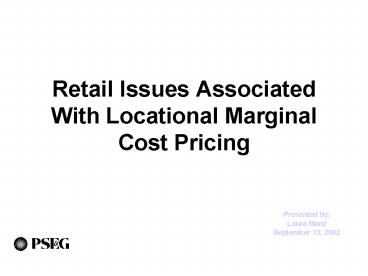Retail Issues Associated With Locational Marginal Cost Pricing - PowerPoint PPT Presentation
Title:
Retail Issues Associated With Locational Marginal Cost Pricing
Description:
LMP works with an open spot market that serves as a solid foundation for retail ... Laura.Manz_at_pseg.com 973-430-3831. 11. LMP is Key ... – PowerPoint PPT presentation
Number of Views:25
Avg rating:3.0/5.0
Title: Retail Issues Associated With Locational Marginal Cost Pricing
1
Retail Issues Associated With Locational Marginal
Cost Pricing
Presented by Laura Manz September 13, 2002
2
Why LMP?
- LMP works with an open spot market that serves as
a solid foundation for retail choice where even
small Load Serving Entities without large
portfolios can obtain market-priced balancing to
manage their contract and delivery risk. LMP
makes the balancing prices fair and efficient.
3
Retail Choice Rests on a Solid Wholesale
Foundation
- LMP provides transparency in spot energy and
transmission pricing to provide the platform for
retail choice - No hidden congestion uplift
- ARRs/FTRs/CRRs for price certainty
- Provides short run signals for energy and
transmission prices and long run signals for
planning and expansion - Provides information that enables choices on how
to use the price signals to benefit customers - Economic signals to regulators, market
participants, and (ultimately) consumers - For settlements, LMPs can be individual nodes or
aggregated blends
4
LMP, Based on Integrated Dispatch Functions
RTO Functions
Market Inputs
Market Support
Ensure Reliability
Generator Bids
Cover Imbalances
A/S Markets
Co-Optimized
Real-Time Balancing
Regional Security- Constrained Economic Dispatch
Load Bids
Buy and Sell Spot Energy
Buy Through Congestion (LMPB - LMPA)
Bilateral Schedules
Congestion Redispatch
Calculate Nodal Spot Prices
Hedge Congestion (LMPB - LMPA)
Self Schedules
Allocate Auction FTRs
Market-Driven Decisions
Settlements at LMP Prices
5
Value Added Services
- LMP prices the security-constrained economic
dispatch and thus provides the correct signals
for managing and expanding the grid - This efficiency requires retailers to focus on
value added services - Once wholesale prices are reasonably reflected to
customers, the focus of retailers will
necessarily shift away from arbitraging price
disconnects and seasonal shifting to capture
economic value from wholesale/retail price
disconnects
6
Why Fixed Retail Credits Require Restrictions on
Switching
7
The Importance of Demand Response
- A well-functioning market encompasses bids and
offers from supply and demand - Day-ahead markets are very helpful in enabling
market-based demand response - Although jump start programs may be necessary
in the short run, they will distort values over
the long run - The correct way to compensate for demand
reduction is to not charge for energy not used - Customers with interval meters can be credited
and charged for market-based purchases and sales
8
Creating a Level Playing Field
Demand - 1 MW _at_ LMP
Supply - 1 MW _at_ LMP
1 less MW charged at its LMP
1 less MW paid at its LMP
Transmission D 1 MW _at_ LMP
9
Creating a Level Playing Field
Demand 1 MW _at_ LMP
Supply 1 MW _at_ LMP
1 more MW charged at its LMP
1 more MW paid at its LMP
Transmission D 1 MW _at_ LMP
10
States play a key role
- Transparent market prices at wholesale provide
the foundation for states to connect customers to
market prices - States can connect customers to markets by basing
retail rates on LMP spot prices - Measurement is a key factor to enabling
meaningful behavior - Ability to measure response and credit/charge at
the real-time price - Interval meters, not necessarily real-time
(reliability) meters to measure interval usage
11
LMP is Key
- LMP pricing provides the correct signals for
demand-side response - the most important missing
element in most markets































